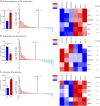Pro-Inflammatory Molecules Implicated in Multiple Sclerosis Divert the Development of Human Oligodendrocyte Lineage Cells
- PMID: 40393021
- PMCID: PMC12094787
- DOI: 10.1212/NXI.0000000000200407
Pro-Inflammatory Molecules Implicated in Multiple Sclerosis Divert the Development of Human Oligodendrocyte Lineage Cells
Abstract
Background and objectives: Oligodendrocytes (OLs) and their myelin-forming processes are lost during the disease course of multiple sclerosis (MS), targeted by infiltrating leukocytes and their effector cytokines. Myelin repair is considered to be dependent on recruitment and differentiation of oligodendrocyte progenitor cells (OPCs). The basis of remyelination failure during the disease course of MS remains to be defined. The aim of this study was to determine the impact of the proinflammatory molecules tumor necrosis factor-⍺ (TNF⍺) and interferon-γ (IFNγ) on the differentiation of human OPCs.
Methods: We generated human OPCs from induced pluripotent stem cells with a reporter gene under the OL-specific transcription factor SOX10. We treated the cells in vitro with TNF⍺ or IFNγ and evaluated effects regarding cell viability, expression of OL lineage markers, and coexpression of astrocyte markers. To relate our findings to the molecular properties of OPCs as found in the MS brain, we reanalyzed publicly available single-nuclear RNA sequencing (RNAseq) datasets.
Results: Our analysis indicated that both TNF⍺ and IFNγ decreased the proportion of cells differentiating into the OL lineage, consistent with previous reports. Uniquely, we now observe that the TNF⍺ effect is linked to aberrant OPC differentiation in that a subset of O4+, reporter-positive cells coexpressing the astrocytic marker aquaporin-4. At the transcriptomic level, the cells acquire an astrocyte-like signature alongside a conserved reactive phenotype while downregulating OL lineage genes. Analysis of single-nuclear RNAseq datasets from the human MS brain revealed a subset of OPCs expressing an astrocytic signature.
Discussion: In the context of MS, these results imply that OPCs are present but inhibited from differentiating along the OL lineage, with a subset acquiring a reactive and stem cell-like phenotype, reducing their capacity to contribute toward repair. These findings help define a potential basis for the impaired myelin repair in MS and provide a prospective route for regenerative treatment.
Conflict of interest statement
The authors report no relevant disclosures. Full disclosure form information provided by the authors is available with the full text of this article at
Figures





References
MeSH terms
Substances
LinkOut - more resources
Full Text Sources
Medical
